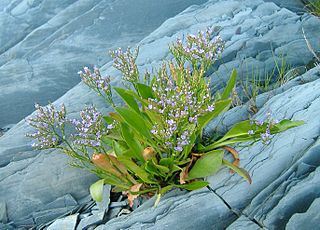Related Research Articles

Geranium is a genus of 422 species of annual, biennial, and perennial plants that are commonly known as geraniums or cranesbills. They are found throughout the temperate regions of the world and the mountains of the tropics, but mostly in the eastern part of the Mediterranean region.

Geranium viscosissimum, commonly known as the sticky purple geranium, is a perennial in the flowering plant family Geraniaceae. It is thought to be a protocarnivorous plant.

Geranium carolinianum is a species of geranium known by the common name Carolina crane's-bill, or Carolina geranium. This species is native to North America, where it is widespread and grows in many types of habitat. There are two varieties; Geranium carolinianum var. carolinianum and the Geranium carolinianum var. sphaerospermum. This is a summer or winter annual herb. It can be considered invasive depending on the region, when it is found in the United States it is considered to be native.
Streptomyces scabies or Streptomyces scabiei is a streptomycete bacterium species found in soils around the world. Unlike most of the 500 or so Streptomyces species it is a plant pathogen causing corky lesions to form on tuber and root crops as well as decreasing the growth of seedlings. Along with other closely related species it causes the potato disease common scab, which is an economically important disease in many potato growing areas. It was first described in 1892, being classified as a fungus, before being renamed in 1914 and again in 1948. Several other species of Streptomyces cause similar diseases to S. scabies but other, more closely related species, do not.

Streptomyces hygroscopicus is a bacterial species in the genus Streptomyces. It was first described by Hans Laurits Jensen in 1931.

Common scab is a plant disease of root and tuber crops caused by a small number of Streptomyces species, specifically S. scabies, S. acidiscabies, S. turgidiscabies and others. Common scab mainly affects potato, but can also cause disease on radish, parsnip, beet, and carrot. This plant disease is found wherever these vegetables are grown.
Synanthedon geranii is a moth of the family Sesiidae. It is found in Greece.
Streptomyces alni is a Gram-positive, aerobic, mesophilic bacterium species from the genus of Streptomyces which has been isolated from roots of the tree Alnus nepalensis in Xishuangbanna on the Nannuo Mountain in China.
Streptomyces griseorubens is a bacterium species from the genus of Streptomyces which has been isolated from soil.
Streptomyces harbinensis is a bacterium species from the genus of Streptomyces which has been isolated from roots of the soybean Glycine max in Harbin in the Heilongjiang province in China. Streptomyces harbinensis produces ikarugamycin
Streptomyces heilongjiangensis is a bacterium species from the genus of Streptomyces which has been isolated from the root surface of the soybean Glycine max in Hulin in the Heilongjiang province in China. Streptomyces heilongjiangensis produces borrelidin.
Streptomyces hokutonensis is a bacterium species from the genus of Streptomyces which has been isolated from rhizosphere roots from strawberries in Hokuto, Yamanashi in Japan.
Streptomyces ipomoeae is a bacterium species from the genus of Streptomyces which has beein isolated from rot from potatoes. Streptomyces ipomoeae produces thaxtomin C and ipomycin. Streptomyces ipomoeae can cause soft rot disease on sweet potatoes.
Streptomyces violascens is a bacterium species from the genus of Streptomyces which has been isolated from soil. Streptomyces violascens produces violapyrone A – G, L-glutamate oxidase and albaflavenoid.
Streptomyces polygonati is a bacterium species from the genus of Streptomyces which has been isolated from the root of the plant Polygonatum odoratum in Harbin in China.

The geranium miner bee is a species of miner bee in the family Andrenidae. Another common name for this species is the geranium andrena. It is found in North America.

Limonium carolinianum, known variously as Carolina sealavender, canker root, ink root, marsh root, lavender thrift, American thrift, or seaside thrift, is a species of flowering plant native to the eastern shores of North America, from northern Mexico to Canada. It is a slow-growing perennial herb found in salt marshes and other maritime habitats. Its inflorescences are frequently harvested for use in cut flower arrangements.
Streptomyces mimosae is a bacterium species from the genus of Streptomyces which has been isolated from the root of a Mimosa pudica plant in Thailand.
References
- 1 2 "Species: Streptomyces geranii". LPSN.DSMZ.de.
- 1 2 Li, Xiaoguang; Lai, Xinting; Gan, Longzhan; Long, Xiufeng; Hou, Yanyan; Zhang, Yuqing; Tian, Yongqiang (1 August 2018). "Streptomyces geranii sp. nov., a novel endophytic actinobacterium isolated from root of Geranium carolinianum L." International Journal of Systematic and Evolutionary Microbiology. 68 (8): 2562–2567. doi: 10.1099/ijsem.0.002876 . PMID 29944094.